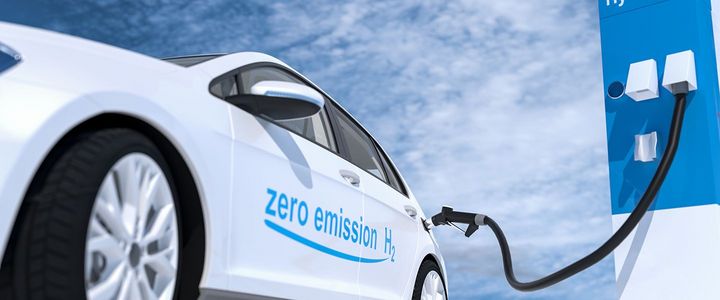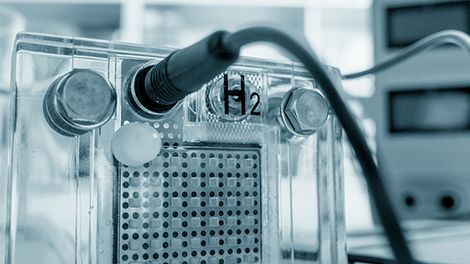Hydrogen in the mobility sector
Although the public discussion around conventional combustion engines and alternative forms of propulsion has been going on for years, the mobility sector has not made any significant progress in reducing emissions. For example, according to the Federal Environment Agency, CO2 emissions from the transport sector were 153 million tonnes of CO2 equivalents in 2010 - and 149 million tonnes in 2020, which represents a 20% share of Germany's greenhouse gas emissions.
In light of the National Hydrogen Strategy adopted on June 10, 2020, it is important to develop technology and infrastructure solutions as well as to create framework conditions that enable an economical path towards the electrification of mass mobility. The role that fuel cell-powered vehicles will play is currently still open, although it is becoming apparent that hydrogen has the potential to establish itself in vehicle concepts that are designed for long distances and high mileages. The expansion of hydrogen mobility will benefit in particular from the planned development of production and transport capacities in the hydrogen economy.
Hydrogen car safety
During regular operation of a hydrogen car, oxygen and hydrogen cannot come into contact with each other because the hydrogen is stored separately from the oxygen in tanks. These must be much more pressure-resistant than conventional petrol tanks. For large amounts of hydrogen to be released at all in an accident, it would have to be an incident like a total loss. Even in crash tests, there was neither damage to the tanks nor any leakage of hydrogen. There is a higher risk of explosion with hydrogen if it is released in an enclosed space.
This includes tunnels or garages, which must be protected against the dangers of hydrogen by additional ventilation and other safety measures. Hydrogen cars, however, are secured in such a way that explosive mixtures are prevented in the event of a fire: Before an explosive mixture can develop, the heated hydrogen is discharged and burned in the fire. Due to the existing safety measures, hydrogen cars can also be parked in garages and car parks.
Hydrogen in the railway sector
Hydrogen replaces diesel propulsion in the rail network
Around 40 % of the German rail network is not electrified. Up to now, diesel railcars have been used almost exclusively for passenger transport on these overhead line-free railway lines. Converting from diesel to hydrogen technology is a particularly economical, environmentally friendly and sustainable solution. Regional trains, for example, can be operated with green hydrogen while retaining the train architecture and without significant changes to the centre of gravity.
Successful test phase of hydrogen trains in Lower Saxony
To test such a platform solution, two hydrogen-powered Coradia iLint trains from the manufacturer Alstom went into operation in the Weser-Ems network in 2018. The trains have a range of 600-800 kilometres and have tanks installed on the roof that are filled with gaseous hydrogen at a pressure of 350 bar. With the addition of oxygen from the environment, the hydrogen is converted into electricity in the fuel cell stacks, which are also located on the roof, and fed into batteries, which temporarily store the electricity and release it as needed.
In addition to providing the drive energy, the batteries also store the braking energy, thus contributing to the high energy efficiency of the entire system. The trains are supplied via a mobile hydrogen filling station. Due to the success of the 18-month test phase, the Lower Saxony regional transport company evb plans to increase the number of hydrogen-powered regional trains and to build a stationary hydrogen refuelling station in Bremervörde with a capacity of around 1,600 kg of hydrogen per day.
Expansion of hydrogen mobility on the railways
Following Lower Saxony's example, the Rhein-Main-Verkehrsverbund is following suit with the world's largest fleet of Coradia iLint fuel cell-powered regional trains to date, as well as its own hydrogen reguelling station for passenger trains. In Baden-Württemberg, too, the replacement of diesel multiple units with fuel cell-powered trains and the construction of corresponding refuelling stations are planned - a regional train developed by Deutsche Bahn together with Siemens on the basis of the Mireo Plus regional multiple unit will be used in the Tübingen area.
From the standard-compliant integration of tank systems into existing infrastructures to the specific monitoring of hydrogen systems and the inspection of tank facilities - with comprehensive services in the areas of testing, inspection and certification, we accompany you from the concept phase, through production, to the operation of your facility.
Hydrogen is a topic with many facets - from production, transport and storage to use. With our expertise, know-how and many years of experience, we are an independent partner for safety and security by being able to test, inspect and certify various aspects of hydrogen technology.
Hydrogen refuelling stations and filling stations
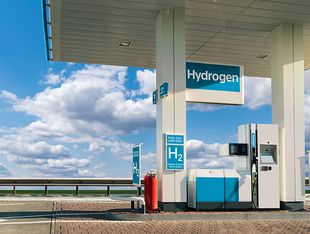
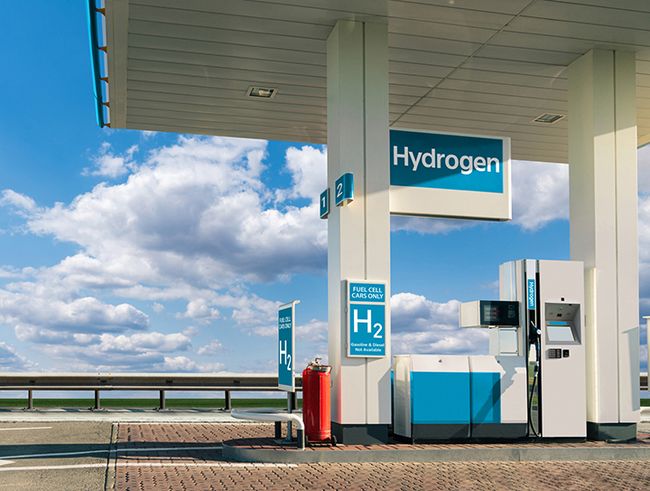
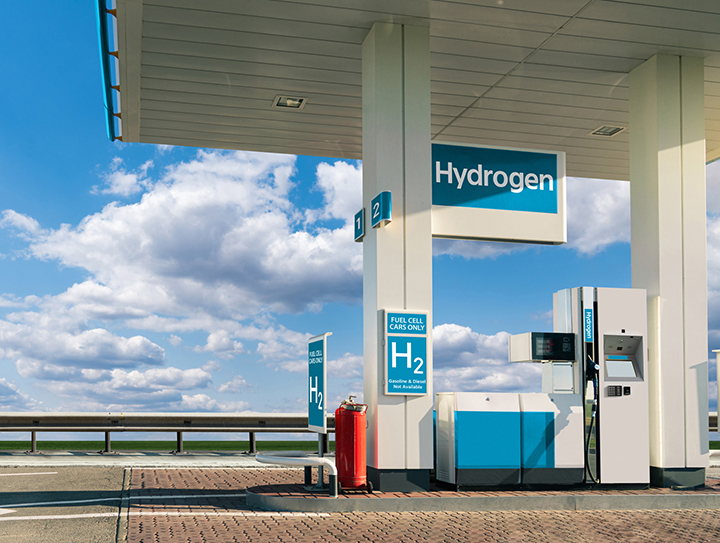

Hydrogen refuelling of road and rail vehicles takes place via refuelling stations that enable supply at different pressure levels. In addition to stationary H2 refuelling stations, mobile refuelling stations for hydrogen cars also exist. Of importance is the technology for hydrogen storage and compression, which is chosen depending on the initial state of the hydrogen (liquid or gaseous) and the number and type of vehicles to be refuelled. The high pressure levels also pose a special challenge to the sealing technology of tank systems.
As part of the development of a hydrogen infrastructure, a network of stationary hydrogen refuelling stations is being set up in Germany, where road vehicles can be refuelled with gaseous hydrogen. In addition, there are small systems, for example for the refuelling of fuel cell forklifts, mobile hydrogen refuelling stations for specific local demand coverage, and refuelling stations for fuel cell-powered trains. Most refuelling stations are supplied with hydrogen by hydrogen trailers, some have an elektrolyzer in which hydrogen is produced on site.
Gaseous hydrogen at the H2 refuelling station
Gaseous hydrogen is stored at H2 refuelling stations in pressure vessel bundles, elevated tanks or underground cylindrical steel tanks. For refuelling, compressors reduce the volume of the hydrogen and compress it to the required pressure levels. Currently, most hydrogen refuelling stations are designed to refuel cars with 700 bar within about three minutes. Refuelling stations with suitably large compressors can also supply commercial vehicles with 700 bar.
To refuel hydrogen buses and hydrogen trucks, refuelling stations need a 350-bar tap, while the pressure tanks of trains are refuelled with 250 bar. Thermal management also plays an important role in the process flow of a refuelling station. Hydrogen is brought to a temperature of -40 °C for gaseous refuelling. For storage in the gaseous state, this is done by cooling equipment; for storage in the liquid state, a cryogenic pump is used to heat the -253 °C cold hydrogen.
Liquid hydrogen at hydrogen refuelling stations
While the storage and transport of liquid hydrogen has long been common practice, its use as an energy carrier in vehicles is still being researched. After initial trials with liquid hydrogen-powered passenger cars, trucks are now the main focus of vehicle development and the adaptation of refuelling stations. Here, refuelling procedures are being tested that avoid the boil-off effect of gaseous refuelling and also make the complex data communication between H2 refuelling station and vehicle superfluous. Boil-off refers to the continuous evaporation that occurs when heat enters tanks containing liquid hydrogen.
Compared to gaseous hydrogen, liquid hydrogen is significantly colder (temperature: -253 °C) and requires significantly improved insulation of pressure vessels and pipelines. On the other hand, its higher energy density also allows refuelling at a lower pressure level and the use of smaller and lighter tanks with a greater vehicle range. Once the first pilot stations for refuelling with liquid hydrogen are set up and the test phase is successfully completed, liquid hydrogen technology could make an additional contribution to the decarbonization of road transport, especially in the area of long-haul transport.
